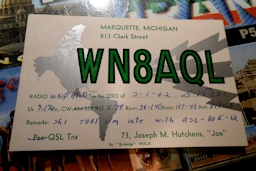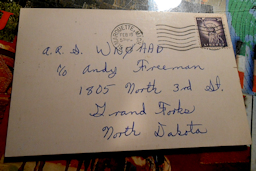The Beginning

 [ MARQUETTE, MICHIGAN ] I got interested in
amateur radio around 1960 when my grandmother gave me an old AM table radio. I looked forward to the
sun setting, because it made that little radio come alive with music and news from all over the
country. Listening to that radio transported me to many far off places, but little did I know that it
was only...the beginning!
[ MARQUETTE, MICHIGAN ] I got interested in
amateur radio around 1960 when my grandmother gave me an old AM table radio. I looked forward to the
sun setting, because it made that little radio come alive with music and news from all over the
country. Listening to that radio transported me to many far off places, but little did I know that it
was only...the beginning!
It didn't take too long before curiosity got the best of me. I wanted to know what made that little
cream colored box work. What were those small lights coming from inside the box? What was causing
the box to keep me warm during the winter, and what was that strange odor? All I needed was a
screwdriver.
(Could it be that only three screws were holding all the little radio's secrets?)
When I managed to slide the radio chassis out of its enclosure, I noticed a couple large glass objects that
glowed. Yes, they were hot, and had a peculiar odor. (Three mysteries solved.) There was
also an arrangement of metal cans, and a funny looking "thing" that rotated when the front dial was
moved. Upon closer investigation, I saw that this "thing" had a couple of screws on top that looked
loose, so I proceeded to tighten them.
(Not knowing a great deal about electricity, I had the radio turned on while it was out of the case.
While tightening the screws, I experienced my first electric shock. Safety first?!)
Well, I noticed right away that moving those screws made the radio stations jump across the dial. I
would turn the screws a little, and then go looking for the radio station at its new location on the
dial. It was during one of those searches that I heard a man talking to another about antennas and
radios. Every couple of minutes each would say "over."
My dad listened, and he said he thought they were called "ham operators!" He didn't know much else, but
promised to see if he could find a book on the subject. (As I recall, he didn't say anything about the
radio being all apart, or the fact that the radio was picking up conversations it shouldn't.)
Not too long after that, my father brought home a couple books published by ARRL, the American Radio Relay
League. The books explained that a license was required to become an amateur radio operator. One
was full of study questions and answers, and the second was a guide on how to learn Morse code.
And, that's how it all started...

 [ MARQUETTE, MICHIGAN ] My dad bought me a
Hallicrafters SX-140 ham-band short-wave receiver in 1961.
[ MARQUETTE, MICHIGAN ] My dad bought me a
Hallicrafters SX-140 ham-band short-wave receiver in 1961.
Of course, I had to put up some antennas, so Dad and I went off in the woods to cut down three trees.
(Imagine us hauling those trees back to town on top of Dad's old Plymouth. Each was close to 30
feet.) We stripped them, let them dry, and put them up after a few weeks. We ran one antenna from
the peak of the roof to a pole on the back property line, and strung another between the two remaining poles
placed 75 feet apart along the side property line.
After studying a few months, I tested and received my novice amateur radio license in the Fall with the
call-sign WN8AQL. (For some reason, E=I*R didn't relate to anything I was learning in school, but I did
manage to get my license.)
It was a few months before Dad could afford a transmitter, so I spent many hours listening to and practicing
CW (Morse code). During this time, I also spent many nights listening to the AM broadcast band, because
I found it fascinating to hear stations from all across the country.
While waiting to purchase a transmitter, I visited our local radio store (Northwest Radio Supply). I
spent so much time in that store, I could have been mistaken for a store fixture.
With the help of Popular Electronics magazine, I soon learned all about the finer points of "DXing"
(listening for distant stations), and how radio stations would send souvenir "QSL" postcards or letters to
listeners who would send in detailed reception reports. (Do you realize that a postcard required only a
3 cent stamp in those days?) Soon, it seemed that I was always anxiously waiting for the mailman to
deliver my next new QSL card.
Many of these cards managed to stay with me over the years, and a few of them can be seem on the "Broadcast Station QSL Cards" page. Hopefully,
the cards will bring back memories for some of you. (Sad to say that none of my amateur radio contact
QSL cards survived.)
 Once I got my transmitter, a
Hallicrafters HT-40, and got on-the-air, you couldn't pull me away.
Once I got my transmitter, a
Hallicrafters HT-40, and got on-the-air, you couldn't pull me away.
My own very first QSL card is pictured below. In the early years, many novices had their cards made by
the same printing company, especially this particular design by Walter Ashe Radio. Also pictured below
is my second printed card with the envelope I sent to Andy, WN0AAD (now W0AAA) in 1962. He was nice
enough to send me pictures of each in 2024.
Several years ago, I came across a picture of the man who gave me my first amateur radio exam in 1961.
Ray, W8HK, owned the local photography studio on Washington Street, and was active for many years in
Marquette. He sold the shop and retired to Florida with the call-sign K4HK.
 Ray is now a silent key, but I still
remember sitting in his radio room taking the novice amateur radio exam. Ray's picture and QSL are
pictured below.
Ray is now a silent key, but I still
remember sitting in his radio room taking the novice amateur radio exam. Ray's picture and QSL are
pictured below.
Amateur radio and Boy Scouts seemed closely associated in those days. Since three of us were licensed, we
would occasionally give amateur radio demonstrations at scout jamborees.
Also, Morse code was often used with signaling flags at various activities, and amateur radio stations were
used during many of our outings in the early 60s. The picture to the right was taken in 1961 at a
camp-out, and shows an early Heathkit transmitter with Hallicrafters and National receivers located in a
tent. Yes, there was a generator for power.





 [ MARQUETTE, MICHIGAN ~
BILOXI, MISSISSIPPI ~ NAKHON PHANOM, THAILAND ] From 1963 through 1971, I was a busy young
man. I was attending high school, college, socializing, sometimes working two radio station jobs,
getting married plus joining the military. With so much going on, I got off-track, and I never advanced
in ham radio. In those days, the novice amateur license was only good for a year and it could not be
renewed. I did study and test for a commercial radio operator permit, which was required for my job at
the radio stations, but I never took the next step in amateur radio until several years later.
[ MARQUETTE, MICHIGAN ~
BILOXI, MISSISSIPPI ~ NAKHON PHANOM, THAILAND ] From 1963 through 1971, I was a busy young
man. I was attending high school, college, socializing, sometimes working two radio station jobs,
getting married plus joining the military. With so much going on, I got off-track, and I never advanced
in ham radio. In those days, the novice amateur license was only good for a year and it could not be
renewed. I did study and test for a commercial radio operator permit, which was required for my job at
the radio stations, but I never took the next step in amateur radio until several years later.

However, I always had a short-wave receiver with me, and listened when I could. I sent out reception
reports in my spare time and received QSL cards, but that was about it.
The first picture to the right was taken in 1964. I was 14 years old, a freshman in high school and, I
was getting close to landing my first radio station job.
By late 1968, I was married and in the United States Air Force being trained as an air traffic control radar
technician at Keesler AFB in Biloxi on the Mississippi Gulf Coast. The picture to the far right was
taken in 1969 at Seashore Manor in my 5th floor apartment. It shows my Hallicrafters SX-130
receiver.
I survived hurricane Camille in 1969 while in Mississippi. After my training was completed at Keesler,
I stayed for another year on the Gulf Coast working in the air traffic control training building, until I was
assigned to Southeast Asia in late 1970. While stationed in Nakhon Phanom, Thailand, I used a little
Sony short-wave portable.
In Thailand, a couple of my friends talked me into taking the amateur radio exam to get licensed once
again. That was in 1971. I received the call-sign WB5FCO.
I've found a world of enjoyment in radio, and I've probably spent more time then I should have listening,
learning and playing, but it sure has been fun.
(As a quick side note to my interest in radio in general... I actually got behind the microphone while
in high school and college. A few summer vacations, and many weekends were spent working at the local
1KW AM radio station. I was just 15 years old (1965) when I landed my first broadcasting job, but
that's another story I'll need to cover in a later chapter. Additional pictures are at "WDMJ Radio.")
And, that is the end of the beginning.
Here are some notes from the history books from 1961 through 1963:
In April 1961, the Soviets put the first man in space. The United States followed in May with Alan
Shepard. The Bay of Pigs Invasion was April 17 (one month after I got my first short-wave receiver),
and "The Lion Sleeps Tonight" was the number 1 record in December. 1962 saw John Glenn as the first
American to orbit the earth, the Cuban missile crisis, oral Polio vaccine, and the first live Telstar TV
satellite broadcast. In 1963, the news told of civil rights activists and the growing war in
Vietnam. It was the year Beatlemania began, push-button telephones were introduced, and 1st class
postage cost 5 cents. President John Kennedy, often referred to by his initials JFK, served as the 35th
president of the United States from January 1961 until his assassination in November 1963.
73,
Joe (AJ8MH)
ex: WPE8EUM, WN8AQL, WB5FCO and WJ5MH
Site Quick Links:
1) The Beginning 1961 through
1971 (This Page )
2) The Early Active Years 1972
through 2007
3) Today









